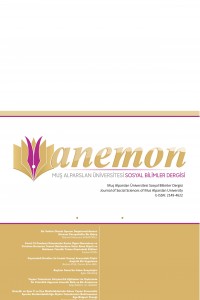Abstract
Change in business organizations may emerge due to both economic and environmental conditions. Another condition that necessitates change is technological developments. The subject of change is sometimes tried to be prevented by being exposed to the employees' resistance. This study aims to examine the conceptual framework of the dinosaur syndrome in the context of change management. We thought that employees' dislike of change and innovations and attempt to prevent them leads them to dinosaur syndrome. Dinosaur syndrome refers to the resistance to change that can be seen in business organizations along with individuals. It should not be forgotten that the basis of the dinosaur syndrome seen in business organizations is also the employees. Dinosaur syndrome emerges in three stages. The first stage consists of encountering, confrontation, and disharmony, and the second stage of resistance to change and rejection of change. And finally, the third stage consists of clumsiness-downsizing, extinction, transformation into another organization. In conclusion, the success of change depends on placing the change as a lifestyle in the business culture, including employees in the change processes as much as possible, and their participative management approach.
References
- Budak, G. & Budak, G. (2018). İşletme yönetimi. Ankara: Nobel Akademik Yayıncılık.
- Çınar, H. (2020). Dinozor sendromu. N. CEMALOĞLU (Ed.), Sendromların eğitim ve yönetime yansımaları. (159-173) içinde Ankara: Pegem Akademi.
- Demir, Y. (2008). İşletme yönetimi açısından değişim mühendisliği yaklaşımı ve uygulanabilirliği. Social Sciences Business Administration. 3(2), 286-295.
- Gökbunar, R. & Ünal, A. G. (1999). Yönetimde dinazorlaşma sendromu ve kamu yönetiminde değişim. Atatürk Üniversitesi İktisadi ve İdari Bilimler Dergisi, 13(1), 45-58.
- Naktiyok, A. (2007). Yenilik yönelimi ve örgütsel faktörler. Atatürk Üniversitesi İktisadi ve İdari Bilimler Dergisi, 21(2), 211-230.
- Özata, M. & Sevinç, İ. (2010). Türk kamu yönetiminde bilgi sistemleri ve e-dönüşüm. Konya: Eğitim Akademi Yayınları.
- Peterson, B. (2016). 3 Signs that your company's a dinosaur -- and how to evolve. Erişim Tarihi: 10.06.2021. https://www.inc.com/ben-peterson/3-signs-that-your-companys-a-dinosaur--and-how-to-evolve.html
- Tekin, M. & Ömürbek, N., (2016). Endüstri 4.0’da teknoloji yönetimi. Konya: Günay Ofset.
- Tengilimoğlu, D., Atilla, E. A. & Bektaş, M. (2020). İşletme yönetimi temel kavramlar çağdaş yaklaşımlar işletme ve yönetim fonksiyonları. Ankara: Seçkin Yayıncılık.
- Tunçer, P. (2011). Yönetimde değişim ve değişim yönetimi teknikleri. Bursa: Ekin Yayınevi.
- Yeşil, S. (2013). Küreselleşme ve değişen çevre dinamikleri ışığında yeni yönetim yaklaşımlarından seçme konular. Ankara: Seçkin Yayıncılık.
- Yeşilyurt, Ö. (2020). Endüstri 4.0 bağlamında sağlık hizmetleri ve yönetiminde nesnelerin interneti teknolojisi. N. YILMAZ & M. N. SALUR (Ed.). Endüstri 4.0 perspektifinden işletme fonksiyonları ve dijital dönüşüm. (115-134) içinde Konya: Necmettin Erbakan Üniversitesi Kültür Yayınları.
- Yeşilyurt, Ö. (2021). Sağlık hizmetleri ve yönetiminde yapay zeka uygulamaları. E. GELMEZ & N. YILMAZ (Ed.) Endüstri 4.0 bakışıyla üretim yönetimi seçme yazılar. (177-198) içinde Konya: Çizgi Kitabevi.
Abstract
İşletmelerde değişim gerek ekonomik gerekse çevresel koşullardan dolayı ortaya çıkabilmektedir. Değişimi zorunlu kılan diğer bir koşul da teknolojik gelişmelerdir. Değişim konusu bazen çalışanların direncine maruz kalarak engellenemeye çalışılmaktadır. Bu çalışmanın amacı değişim yönetimi bağlamında dinozor sendromunun kavramsal çerçevesinin irdelenmesidir. Çalışanların değişimi ve yenilikleri sevmemesi ve engellemeye çalışması durumunun çalışanları dinozor sendromuna yönlendirdiği düşünülmektedir. Dinozor sendromu bireylerde görüldüğü gibi organizasyonlarda da görülebilen değişim karşısındaki direnci ifade etmektedir. Organizasyonlarda görülen dinozor sendromunun temelinde de yine çalışanların olduğu unutulmamalıdır. Dinozor sendromu üç evrede ortaya çıkmaktadır. Birinci evre; karşılaşma, yüzleşme ve uyumsuzluk, ikinci evre; değişim karşısında direnme ve değişimi reddetme, üçüncü evre ise; hantallaşma-küçülme, yok olma, bir başka örgüte dönüşümdür. Sonuç olarak; değişimin başarısı değişimin bir yaşam tarzı olarak işletme kültürü içerisine yerleştirilmesine, çalışanların değişim süreçlerine mümkün olduğunca dahil edilmelerine ve katılımcı yönetim anlayışına sahip olmalarına bağlıdır.
References
- Budak, G. & Budak, G. (2018). İşletme yönetimi. Ankara: Nobel Akademik Yayıncılık.
- Çınar, H. (2020). Dinozor sendromu. N. CEMALOĞLU (Ed.), Sendromların eğitim ve yönetime yansımaları. (159-173) içinde Ankara: Pegem Akademi.
- Demir, Y. (2008). İşletme yönetimi açısından değişim mühendisliği yaklaşımı ve uygulanabilirliği. Social Sciences Business Administration. 3(2), 286-295.
- Gökbunar, R. & Ünal, A. G. (1999). Yönetimde dinazorlaşma sendromu ve kamu yönetiminde değişim. Atatürk Üniversitesi İktisadi ve İdari Bilimler Dergisi, 13(1), 45-58.
- Naktiyok, A. (2007). Yenilik yönelimi ve örgütsel faktörler. Atatürk Üniversitesi İktisadi ve İdari Bilimler Dergisi, 21(2), 211-230.
- Özata, M. & Sevinç, İ. (2010). Türk kamu yönetiminde bilgi sistemleri ve e-dönüşüm. Konya: Eğitim Akademi Yayınları.
- Peterson, B. (2016). 3 Signs that your company's a dinosaur -- and how to evolve. Erişim Tarihi: 10.06.2021. https://www.inc.com/ben-peterson/3-signs-that-your-companys-a-dinosaur--and-how-to-evolve.html
- Tekin, M. & Ömürbek, N., (2016). Endüstri 4.0’da teknoloji yönetimi. Konya: Günay Ofset.
- Tengilimoğlu, D., Atilla, E. A. & Bektaş, M. (2020). İşletme yönetimi temel kavramlar çağdaş yaklaşımlar işletme ve yönetim fonksiyonları. Ankara: Seçkin Yayıncılık.
- Tunçer, P. (2011). Yönetimde değişim ve değişim yönetimi teknikleri. Bursa: Ekin Yayınevi.
- Yeşil, S. (2013). Küreselleşme ve değişen çevre dinamikleri ışığında yeni yönetim yaklaşımlarından seçme konular. Ankara: Seçkin Yayıncılık.
- Yeşilyurt, Ö. (2020). Endüstri 4.0 bağlamında sağlık hizmetleri ve yönetiminde nesnelerin interneti teknolojisi. N. YILMAZ & M. N. SALUR (Ed.). Endüstri 4.0 perspektifinden işletme fonksiyonları ve dijital dönüşüm. (115-134) içinde Konya: Necmettin Erbakan Üniversitesi Kültür Yayınları.
- Yeşilyurt, Ö. (2021). Sağlık hizmetleri ve yönetiminde yapay zeka uygulamaları. E. GELMEZ & N. YILMAZ (Ed.) Endüstri 4.0 bakışıyla üretim yönetimi seçme yazılar. (177-198) içinde Konya: Çizgi Kitabevi.
Details
| Primary Language | English |
|---|---|
| Journal Section | Review Article |
| Authors | |
| Publication Date | August 31, 2021 |
| Acceptance Date | August 3, 2021 |
| Published in Issue | Year 2021 Volume: 9 Issue: 4 |
Anemon Muş Alparslan Üniversitesi Sosyal Bilimler Dergisi Creative Commons Atıf-GayriTicari 4.0 Uluslararası Lisansı (CC BY NC) ile lisanslanmıştır.


